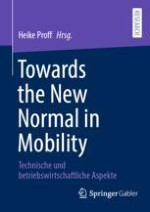2023 | OriginalPaper | Buchkapitel
Ein Vergleich der Kundenwahrnehmung neuer Fahrzeugantriebe mit Fokus auf Risikoprofile, Vertrauen und Nutzungsbereitschaft
verfasst von : Robin Kehl, Jan-Gerrit Grotenhermen, Sören Greve, Gerhard Schewe
Erschienen in: Towards the New Normal in Mobility
Verlag: Springer Fachmedien Wiesbaden
Aktivieren Sie unsere intelligente Suche, um passende Fachinhalte oder Patente zu finden.
Wählen Sie Textabschnitte aus um mit Künstlicher Intelligenz passenden Patente zu finden. powered by
Markieren Sie Textabschnitte, um KI-gestützt weitere passende Inhalte zu finden. powered by
